It’s July. Back in March, we expected that Trump’s Tariff Turmoil (TTT) would become less tumultuous by the end of the summer. We figured that President Donald Trump would start to declare victory in his trade war with the world. We figured he would start to move on to other issues to reduce the risk that his trade war would cause a recession in the US. The political calendar shows that the congressional mid-term election campaigns will be starting in the not-too-distant future. Trump needs a good economy to increase the odds that the Republicans will hold onto their thin majorities in the House and the Senate come November 2026.
In fact, the economy is in very good shape right now. The labor market is at full employment given that the is 4.1%, and inflation, excluding the slow-motion decline in rent inflation, is below 2.0% y/y (Fig. 1 below and Fig. 2 below). The Misery Index, which is the sum of the unemployment rate and the headline CPI inflation rate, is at 6.6%, well below its average over time of 9.0% (Fig. 3 below).
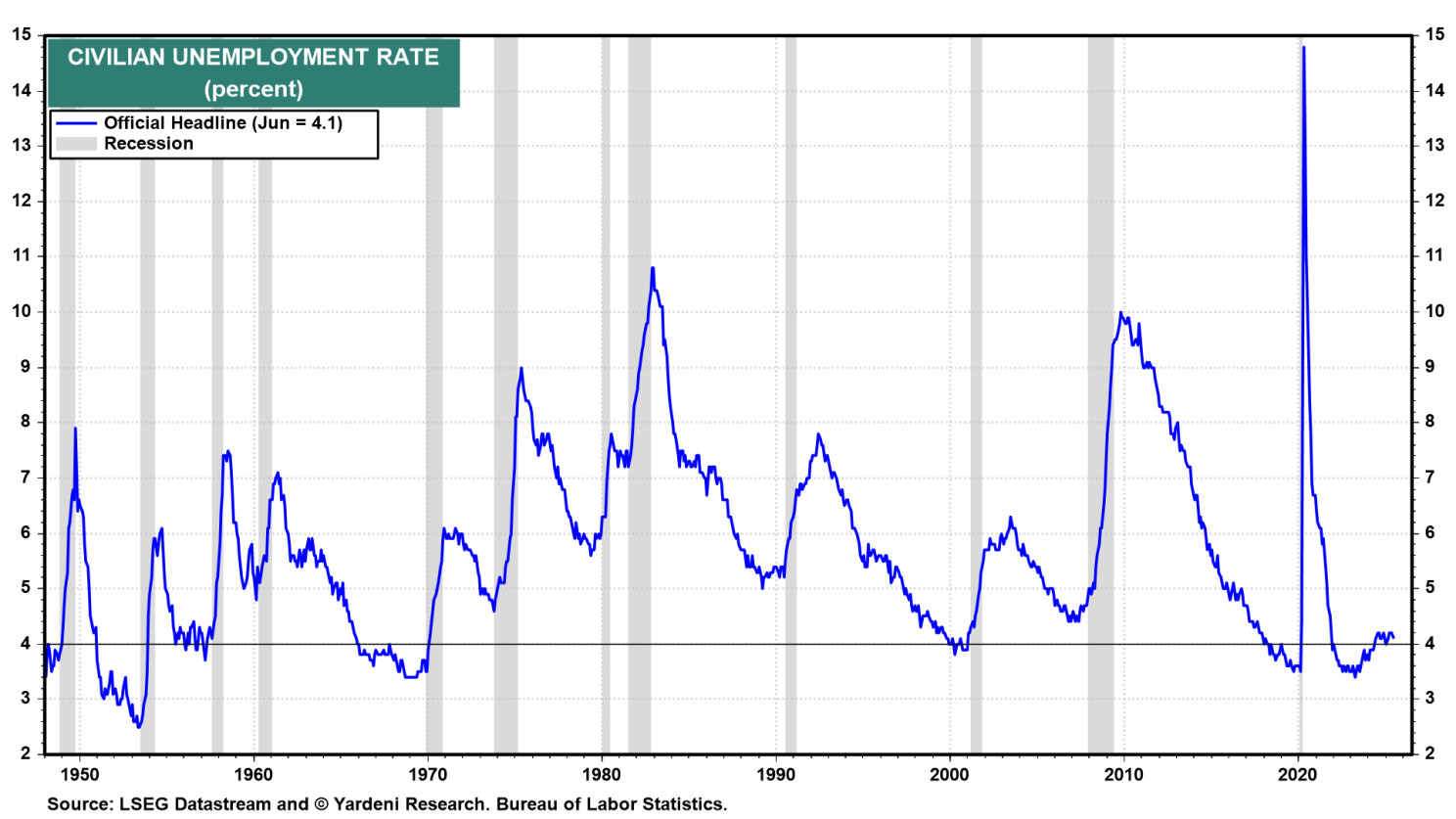
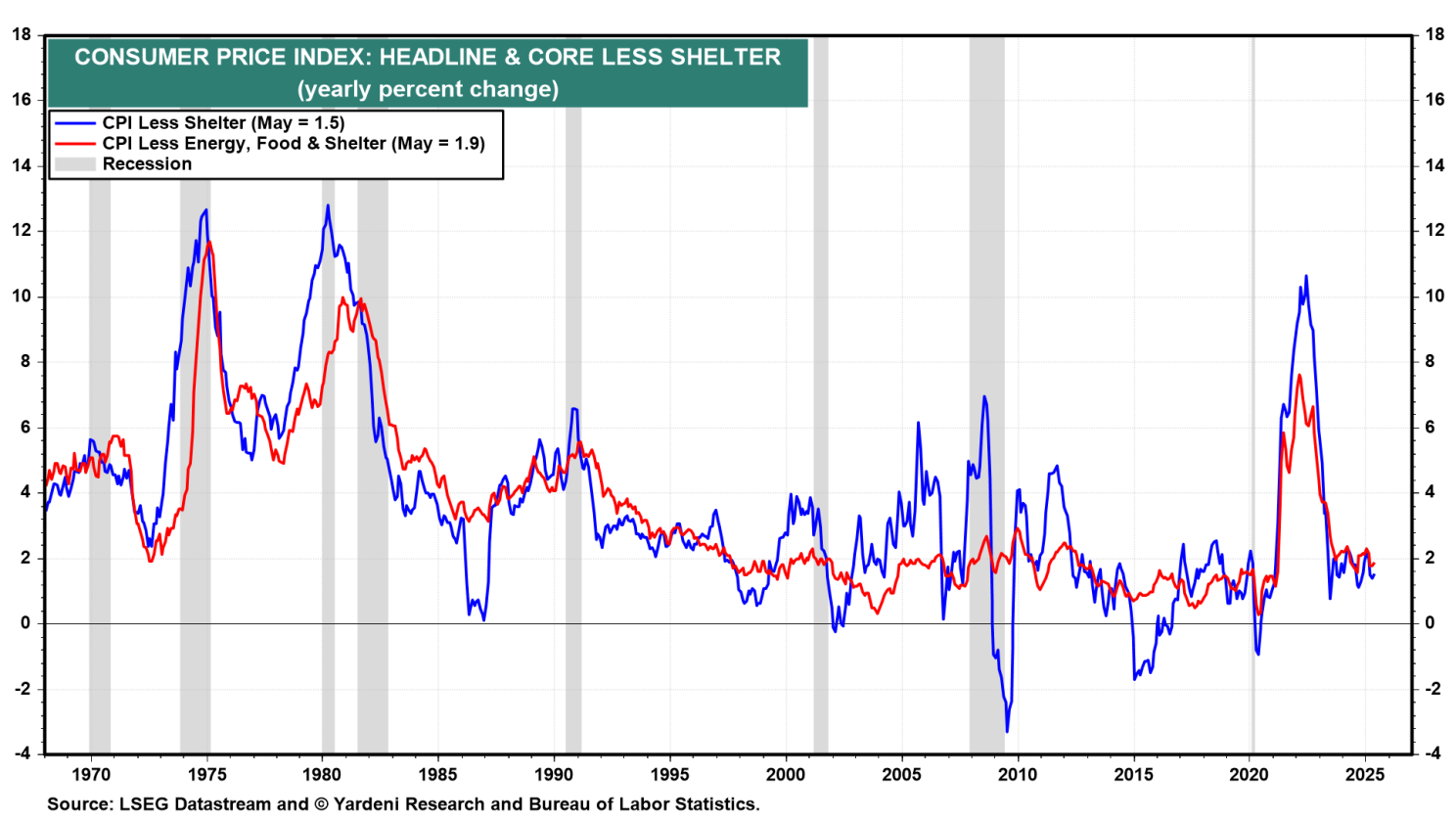
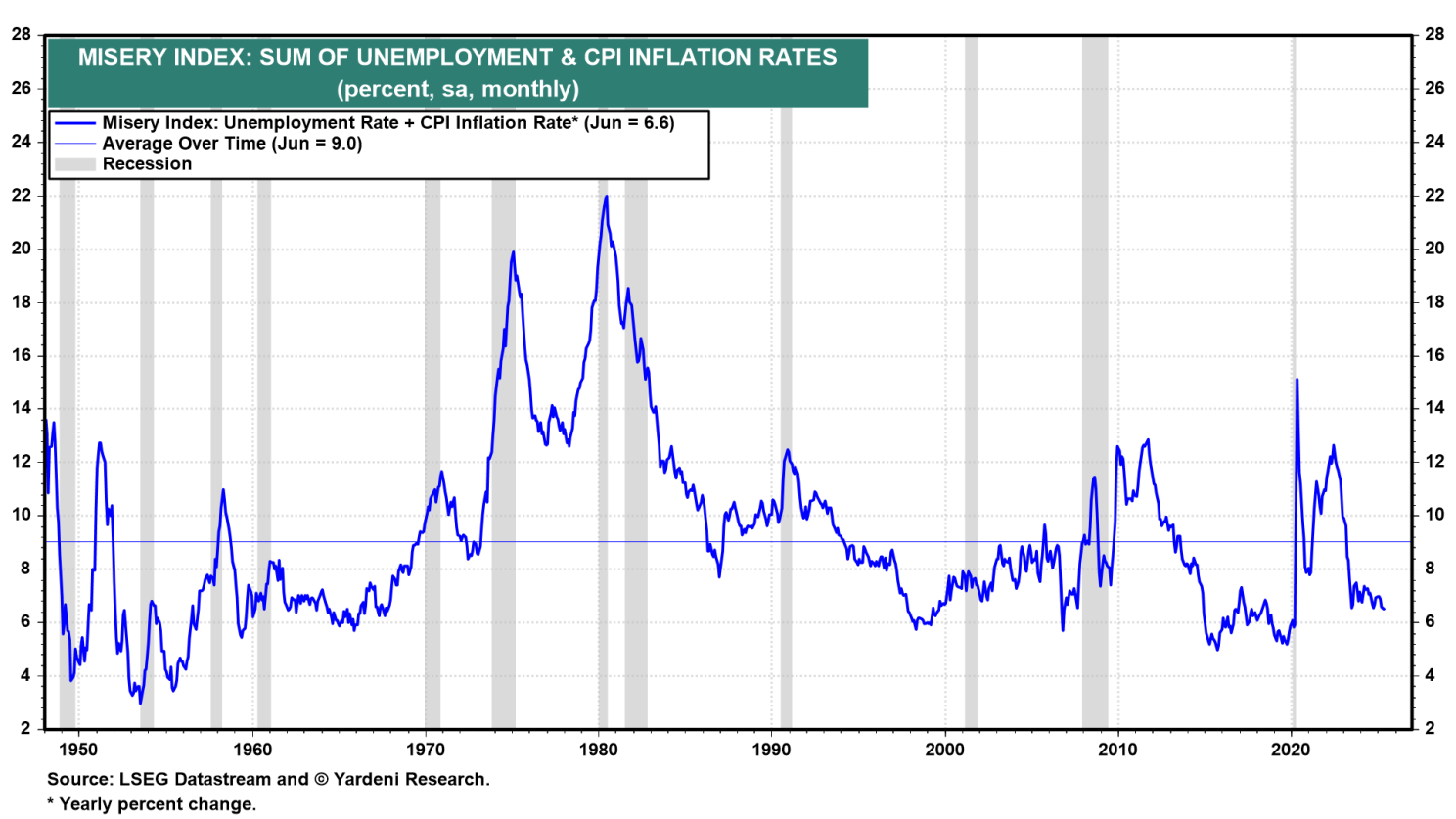
Why should Trump mess with success? Why not spend the time remaining until the elections in November of next year campaigning for Republican congressional candidates on the considerable economic and geopolitical successes of the White House so far?
On March 13, we lowered our year-end target to 6400 from 7000. At the time, the S&P 500 had most recently closed at 5521.52. So we remained bullish. However, we hedged our bet:
“That’s if President Trump relents, as we expect he will to avoid a recession that would cost the Republicans their majorities in both houses of Congress in the mid-term elections in late 2026.”
On March 31, we lowered our target again to 6100 as Trump’s April 2 Liberation Day approached. That was still a bullish outlook given that the S&P 500 closed at 5611.85 that day.
In the April 7 Morning Briefing, we anticipated the bottom in the correction:
“Trump’s Liberation Day last Wednesday triggered Annihilation Days on Thursday and Friday, with the Stock Market Vigilantes giving a costly thumbs-down to Trump’s Reign of Tariffs. Trump officials say they aim to make Main Street wealthy again even if that’s bad for Wall Street. The problem is that Main Street owns lots of equities traded on Wall Street, so the two streets prosper and suffer together.
Congress can’t do much to stop Trump given his veto power, but he might get the message that hurting Main Street’s stock portfolios can cause a recession and jeopardize the GOP majority in Congress. If so, he might postpone the reciprocal tariffs, giving trade negotiations time to work. Also, the courts might block Trump’s tariffs. An early end to Trump’s tariff nightmare would result in a V-shaped stock-market bottom. We’re counting on that; the alternative is just plain ugly.”
The S&P 500 bottomed on April 8. The next day, Trump postponed his Liberation Day reciprocal tariffs on America’s trading partners for 90 days. He continued to moderate his stance on tariffs. The S&P 500 rose to a record high of 6279.35 on July 3, right before Independence Day.
However, since then, Trump has been upping the ante again in his trade war with the world. Effective August 1, Trump will impose reciprocal tariffs on nations that haven’t successfully negotiated a deal with the US. On that date, will face a 50% duty.
Trump is threatening to impose 35% and 50% tariffs on Canada and Brazil, respectively, on August 1. On Saturday, he announced that a 30% tariff on goods from the European Union and Mexico will take effect on August 1. Trump is also threatening to impose a 200% tariff on pharmaceuticals, though that might not go into effect immediately, but be subject to a grace period of “about a year, year and a half to come in.”
In other words, Liberation Day I—which occurred on April 2 and was postponed until July 9 a few days later—will now hit with full force on August 1. Instead of relenting by now, as we had expected he would do, Trump remains unrelenting in his trade war.
In the May 19 Morning Briefing, we concluded that Trump was relenting and following our script to declare victory on the tariff issue by the end of the summer. As a result, we wrote:
“So the odds of our Roaring 2020s scenario is back up to 75%. In this scenario, the S&P 500 rises to 6500 by the end of this year. It could keep going to 7000 in a meltup.”
Liberation Day II (scheduled for August 1) may be Macho Trump’s response to Wall Street’s traders who’ve been betting on the TACO Trump trade. The term “TACO”—Trump Always Chickens Out—was coined by Financial Times commentator Robert Armstrong to describe what he says is the President’s pattern of announcing heavy tariffs on countries, causing economic shock, panic, and stock market hits and then later reversing course with pauses or reductions that create market rebounds.
So what do we do now? We certainly aren’t raising our year-end S&P 500 target of 6500. On July 8, Goldman Sachs raised its target just above ours to 6600. We still think that these nearly the same targets are achievable by the end of the year. However, Trump must get the tariff issue resolved in the coming weeks. For now, the V-shaped stock market recovery could turn into a choppy square-root shaped pattern over the rest of the summer and early fall, followed by a year-end rally.
Trump’s Tariffs II: Macho Versus TACO
Trump may be getting too confident that upcoming data will confirm the resilience of the economy and the slow pace of inflation. He may also be emboldened by the record high in the stock market and the calm in the bond market (Fig. 4 below and Fig. 5 below). Trump’s economists (including our former colleague and good friend Eric Wallerstein, who is now on the Council of Economic Advisers) should warn Trump that the inflation rates for June and July are tracking at 3.0% y/y according to the Cleveland Fed’s Inflation Nowcasting. That would be up from 2.8% in May. In addition, our Earned Income Proxy (for private industry wages and salaries in personal income) was flat in June, suggesting that the month’s key indicators (e.g., ) might be weaker than expected.
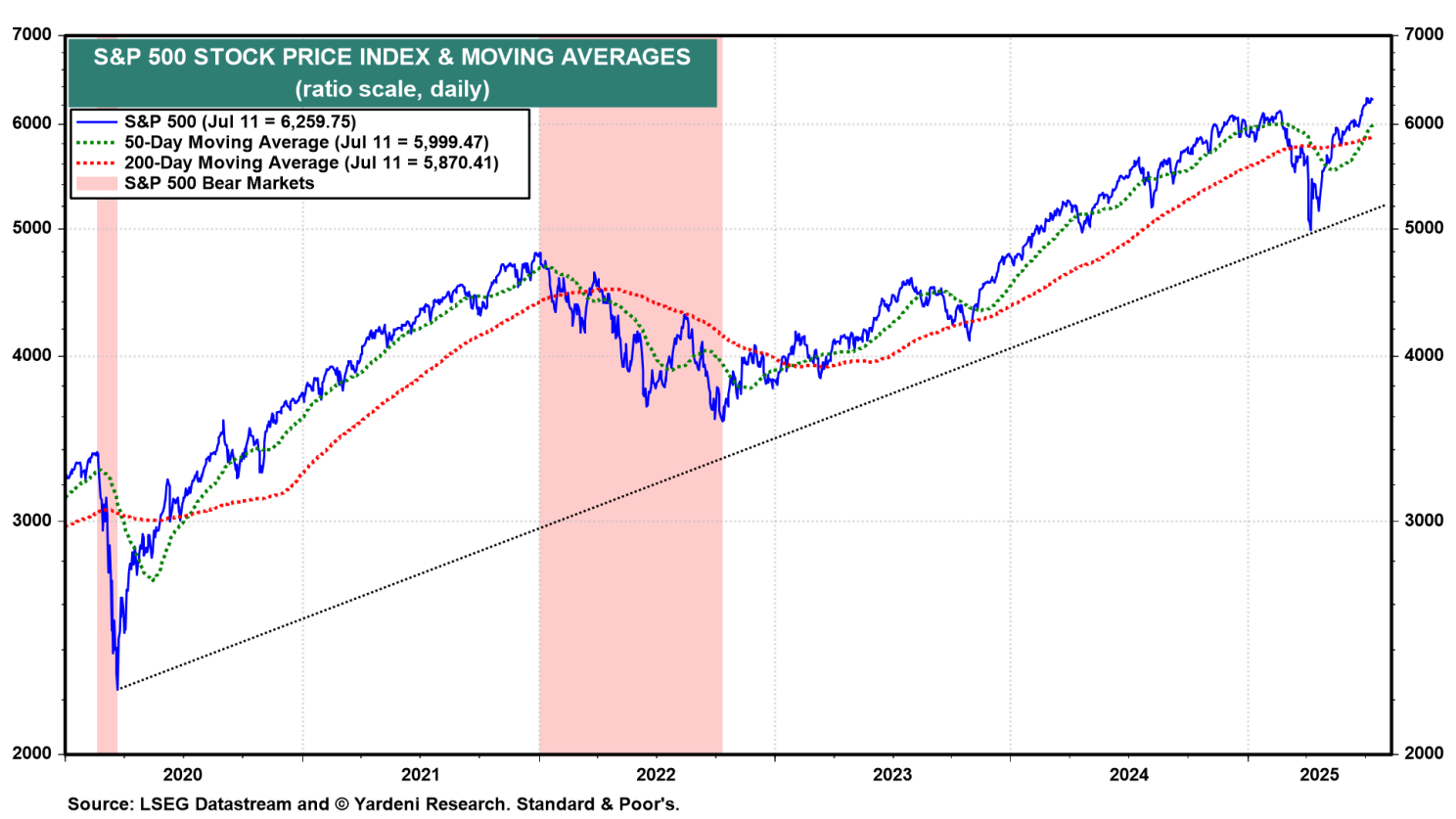
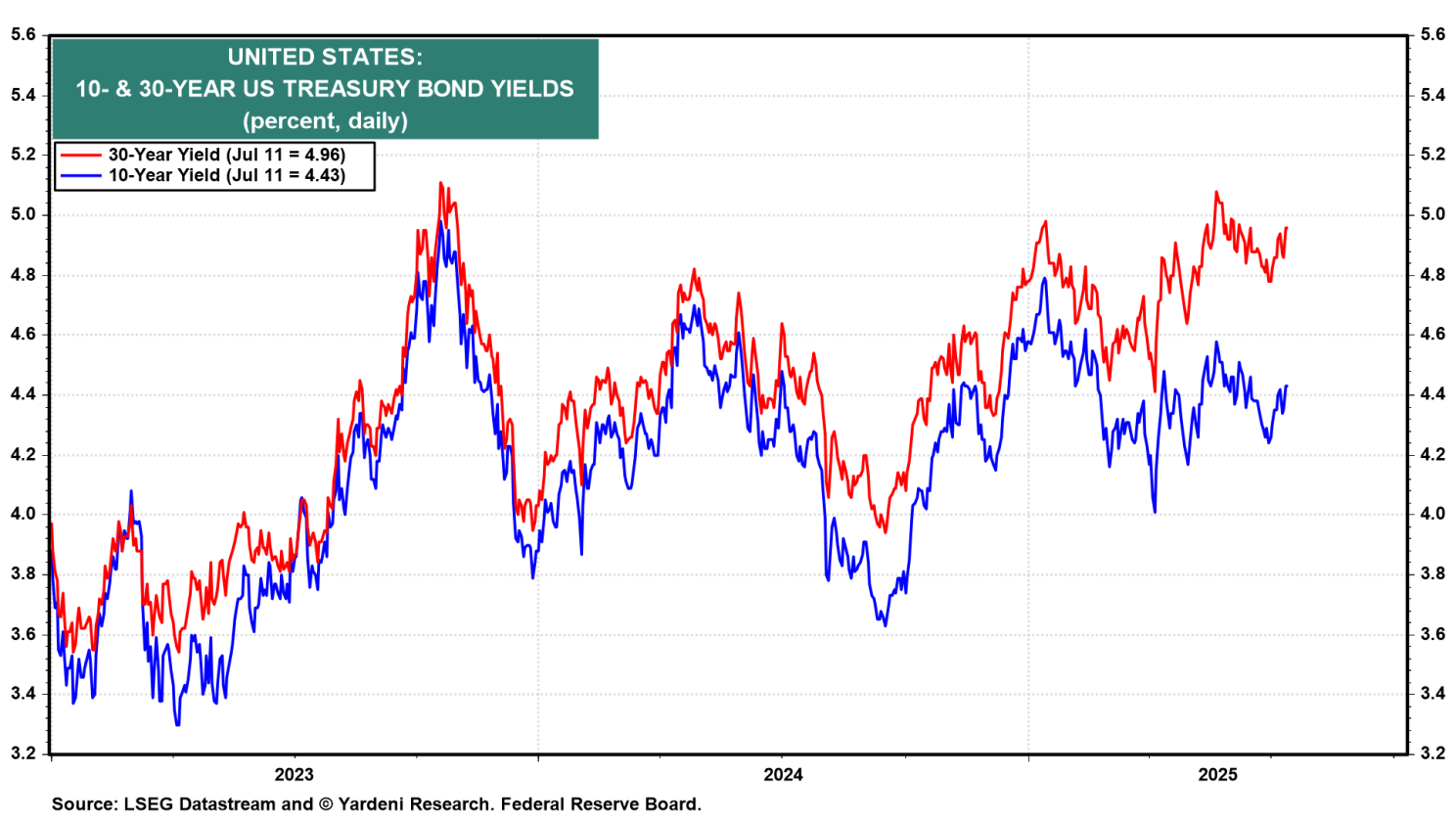
Furthermore, Trump has been haranguing Fed Chair Jerome Powell to resign for months. Trump has criticized Powell for resisting lowering the federal funds rate on the mistaken notion that Trump’s tariffs will boost inflation. The President says his next Fed chair will be “somebody who wants to cut rates,” and he has seized on a new report from Council of Economic Advisers Chair Stephen Miran (Eric’s boss) as evidence of how his vision for growth can succeed in defiance of the views of many economists.
“The Fake News and the so-called ‘Experts’ were wrong again,” the President posted on his social network. “Someone should show [Miran’s] new Study to ‘Too Late’ Jerome Powell, who has been whining like a baby about non-existent Inflation for months, and refusing to do the right thing.”
Trump must have been overjoyed by June’s federal budget news on Friday. He must have loved the headline of the CNBC story written by Jeff Cox: “Treasury posts unexpected surplus in June as tariff receipts surge.”
Cox reported:
“The U.S. government posted a surplus in June as tariffs gave an extra bump to a sharp increase in receipts, the Treasury Department said Friday. With government red ink swelling throughout the year, last month saw a surplus of just over $27 billion, following a $316 billion deficit in May.”
Trump levied across-the-board 10% tariffs on imports in April on top of other select duties. From April through June, customs duties totaled $88 billion, or $352 billion at an annual rate (Fig. 6 below).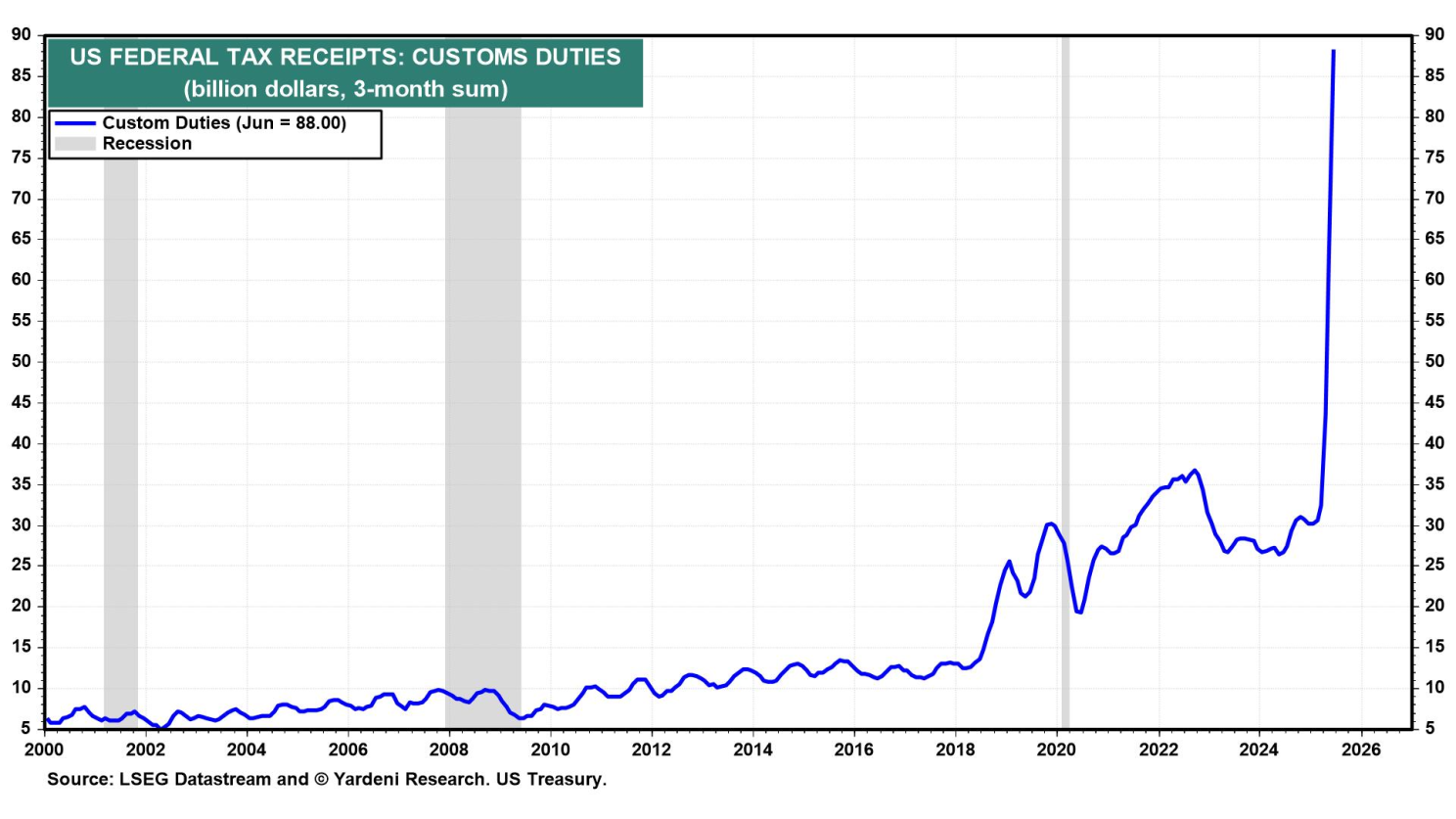
The President told Meet the Press moderator Kristen Welker in a telephone interview on Friday that he plans to set a blanket tariff of 15%-20% on most nations, which would be up from the current 10% base rate. He called the tariffs so far “very well received.” He must figure that if he can raise roughly $300 billion per year with a 10% tariff rate on all imported goods, why not double that amount with a 20% tariff rate (Fig. 7 below)?
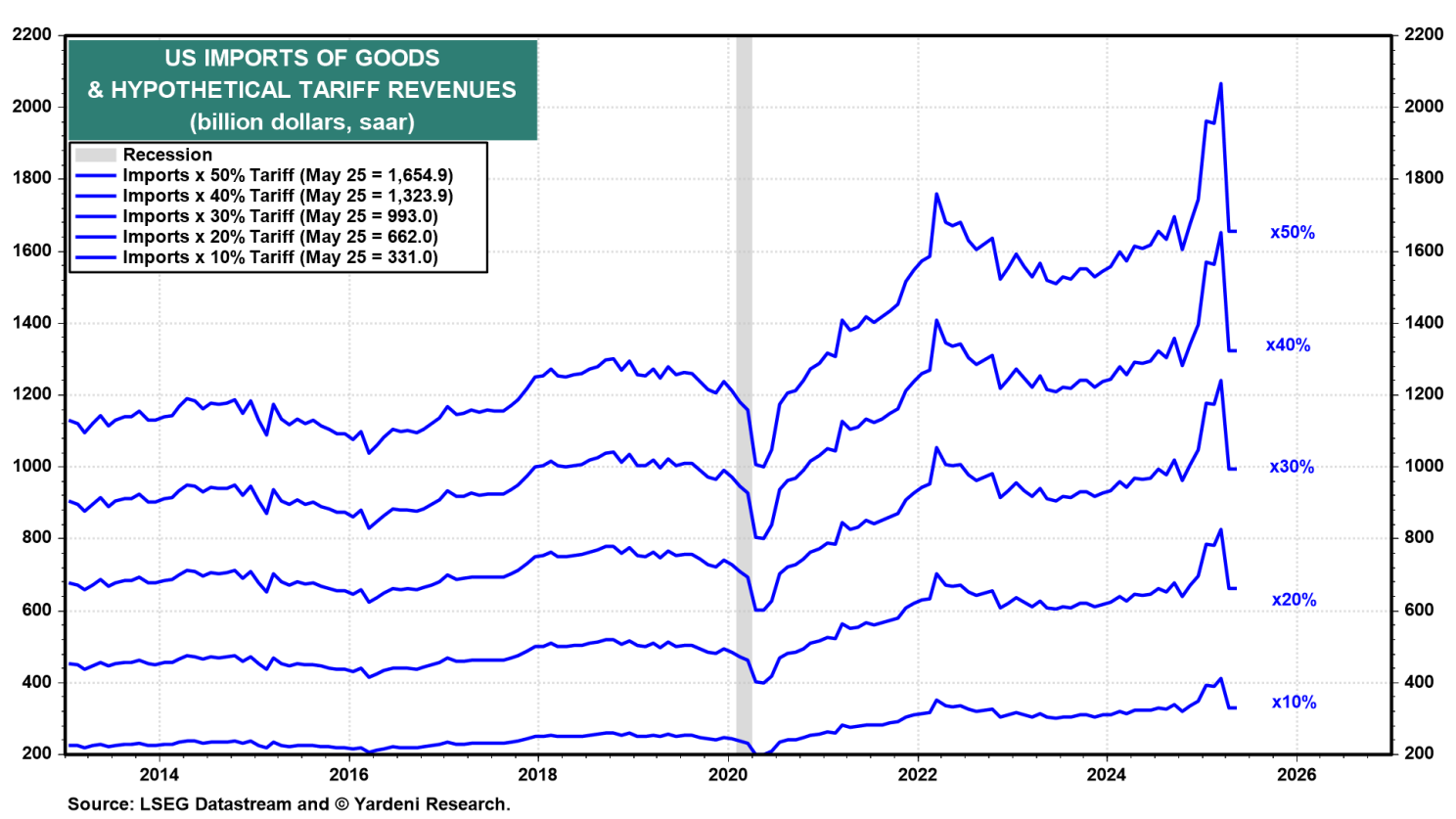
The answer to the question is that tariffs are a tax on US importers, who might try to pass some of this burden onto their overseas vendors or onto their domestic customers. The higher the tariff, the more burdensome is its tax effect. The tariff tax eats into revenues, eroding profit margins and profits.
For perspective, keep in mind that doubling the tariff intake to $600 billion would bring in more money in tariffs than total US corporate tax receipts amounted to—$503.5 billion—over the past 12 months through June (Fig. 8 below). It’s hard to imagine higher tariffs not squeezing corporate profit margins. However, in our Roaring 2020s scenario, rebounding productivity growth might offset some of the corporate burden of higher tariffs.
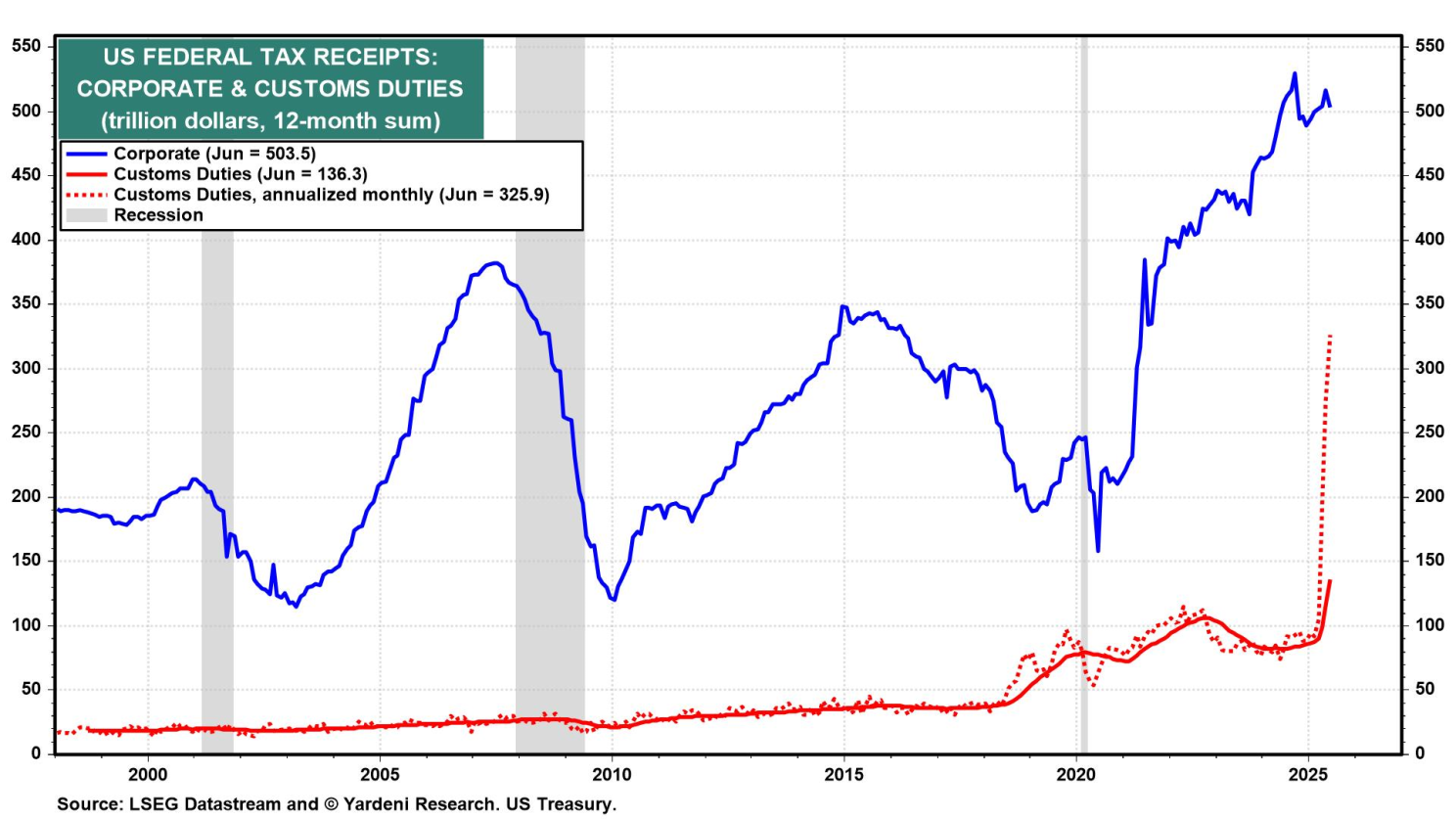
Our humble advice to POTUS: Beware of hubris. Don’t push your luck on tariffs. Also, don’t mess with the Fed’s independence. The Bond Vigilantes will push up bond yields.
Why Are Financial Markets So Calm?
We’ve been responding to this question from accounts and journalists for the past couple of weeks. Shouldn’t the bond and stock vigilantes respond adversely to the escalation of TTT, as they did in early April? The selloffs in the bond and stock markets back then forced Trump to de-escalate his trade war. That’s not happening now—not so far at least. This undoubtedly is emboldening Trump.
Let’s see how the financial markets respond this week to his latest escalation. Perhaps investors have learned that Trump’s huffing and puffing is simply the way he negotiates trade deals. They are betting that it will work and result in lots of deals. They’ve also learned that Trump can change his mind often. So if some trade deals aren’t coming together fast enough, he’ll settle on a vague letter of understanding to work out a deal over time.
The risk for the economy and investors is that Trump has concluded that if the financial markets aren’t going to be vigilant about his trade war, then he can proceed with it unchecked. If so, then TTT will last past the summer. Trump certainly views soaring customs duties as a big win for his approach, even though they amount to a tax increase. Trump likes the power that comes from speaking loudly and carrying big sticks, including tariffs, sanctions, and bunker-busting bombs. This is his leadership approach, and he believes it is working for him and has been the right approach so far.
Then again, investors may agree with our current view that “this too shall pass” by the end of the summer: The economy will remain resilient, and inflation will remain surprisingly moderate. It all adds up to a relatively normal seasonal pattern, with the stock market weak during the late summer through the fall, followed by a year-end rally to 6500 in our scenario.

